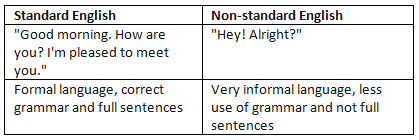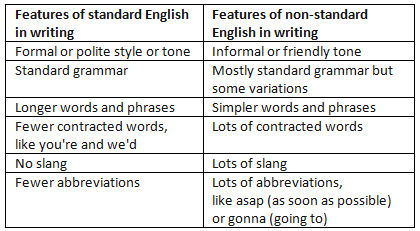Class 4 Exam > Class 4 Notes > Year 4 English > Using standard and non-standard English
Using standard and non-standard English | Year 4 English - Class 4 PDF Download
Understanding Standard English and Non-Standard English
- Standard English:
- Standard English is the form of English that is universally taught and understood across the globe.
- It adheres to correct grammatical rules and is often considered the formal, official, or polite manner of communication.
- Non-Standard English:
- Non-Standard English represents the informal variant of the language, subject to regional variations.
- It includes slang, informal versions of standard words that may be specific to particular regions or social groups, making it less universally understood.
- Examples:
- Standard English: "It is raining outside."
- Non-Standard English: "It's raining cats and dogs."
Using Standard and Non-Standard English
- Definition of Standard and Non-Standard English: Standard English is typically used in formal situations, such as when conversing with unfamiliar individuals like professionals or authority figures, to demonstrate respect and create a positive impression. On the other hand, non-standard English is more commonly used in casual settings among friends and family, where the tone is relaxed.
- Comparison of Standard and Non-Standard English:

- Recognizing the Context: Consider the various individuals you interact with throughout the week. Your behavior and speech are likely influenced by the context of these interactions. For instance, you may adapt your language and tone based on whether you are speaking with a teacher, a close friend, or a family member.
- Impact on Communication: Reflect on how your choice of words and manner of speaking can vary based on the setting. Your communication style might change depending on the formality of the situation and the familiarity of the individuals involved.
Using different forms of English in writing
- Utilization in Writing: Different forms of English are also prevalent in writing contexts.
- Standard English Usage: For tasks like academic assignments or composing formal letters, individuals typically employ standard, formal English.
- Informal Writing Scenarios: Conversely, when crafting text messages, emails, postcards, or letters to friends and family, individuals tend to use non-standard, informal English.
- Main Contrasts in Formal and Informal Writing:

Question for Using standard and non-standard EnglishTry yourself: Which form of English is typically used in formal situations?View Solution
The document Using standard and non-standard English | Year 4 English - Class 4 is a part of the Class 4 Course Year 4 English.
All you need of Class 4 at this link: Class 4
|
49 videos|59 docs|9 tests
|
FAQs on Using standard and non-standard English - Year 4 English - Class 4
| 1. What are the key differences between standard and non-standard English? |  |
Ans. Standard English follows the grammar and vocabulary rules set by language authorities, while non-standard English may include dialects, slang, or informal language variations.
| 2. How does the use of standard English in schools impact students' academic performance? |  |
Ans. Using standard English in schools can help students communicate effectively, improve their writing skills, and enhance their academic performance by adhering to formal language standards.
| 3. Are there any benefits to learning non-standard English in educational settings? |  |
Ans. Learning non-standard English can promote cultural diversity, provide insight into different speech patterns, and help students understand the nuances of language variation in society.
| 4. How can teachers incorporate both standard and non-standard English into their curriculum effectively? |  |
Ans. Teachers can use a balanced approach by teaching standard English for academic purposes while also acknowledging and discussing non-standard English to promote linguistic diversity and inclusivity.
| 5. What role does language variation play in the social context of education? |  |
Ans. Language variation reflects the diverse backgrounds and experiences of students, highlighting the importance of recognizing and respecting different forms of language in educational settings.
Related Searches




















